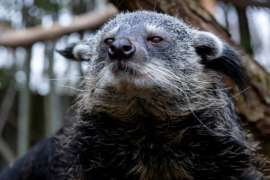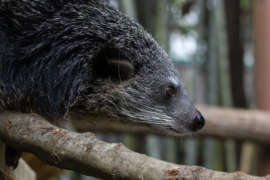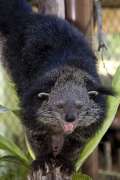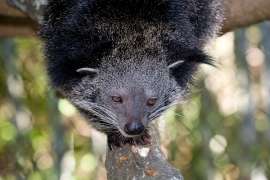Binturong
Binturong
These medium-sized mammals may weigh sometimes up to 50 pounds. They use their prehensile tails and specialized wrists and ankles to maneuver about rainforest trees in search of fruits, bird eggs or small animals.
Arctictis binturong
Omnivore
Southeast Asia [VIEW MAP]
Rainforests
Binturongs sleep much of the day. The binturong at Zoo Atlanta likes to spend time on his specially-constructed hammock near the rear corner of the habitat, but you can usually get an up-close view of this animal on most days. On colder or rainier days, he will generally move to his indoor heated area.
Photos and Videos
Binturongs are related to a group of catlike Asian carnivores in the Family Viverridae, which includes civets and genets. The meaning of the word “binturong” is unknown because the local language that created the word is now extinct. Binturongs are slow-moving and arboreal, spending most of their time in trees. They play an important role in the rainforest ecosystem as seed dispersers. Binturongs are the only animals whose digestive enzymes can soften the coating of the strangler fig seed. The seeds are redistributed into the ecosystem through their feces.
The binturong is sometimes referred to as a “bearcat,” although binturongs are not related to bears or cats. They are actually civets. They are relatively large compared with many arboreal mammals. The binturong’s total body length including the tail is between 4-6 feet. The length of the tail is nearly equivalent to the length of the rest of the body (2-3 feet). They weigh 20 – 50 lbs. Females are about 20% larger and heavier than males. The long prehensile tail is used regularly to maintain position among the branches. When climbing straight up or straight down a vertical tree trunk, their specialized wrists and ankles can pivot the hands and feet either forward or backwards, to allow the sharp claws the best grip on the bark of the tree.
Binturongs are solitary or live in small groups of adults with young, with the female being dominant. They mark their territory through scent. Their scent glands are located near their tails, and their scent is spread on trees as they move through them. Their scent has been compared to that of buttered popcorn or corn chips.
Binturongs also communicate vocally, making a chuckling sound when excited and a high-pitched wail when bothered. They will also hiss, howl, and grunt at one another and toward threatening predators.
Binturongs have no specific mating season, but most reproduction peaks between March to April and October to November. Binturongs are one of the few mammals that experience delayed implantation, meaning that the fertilized egg only partially develops after fertilization, and floats free in the uterus for a variable amount of time before implanting in the uterine wall and forming a placenta.
Gestation is 84 to 92 days, and the young weigh about 5 ounces at birth. Binturongs can have two litters per year, usually with only one or two offspring in each litter. Offspring are born blind and dependent on their mothers. The male occasionally assists in the rearing of the young, and parents will aggressively protect their offspring. At 2 months old, the young begin to eat solid food. They remain with their parents until they are a year old, when they are fully grown.
Binturongs sleep much of the day. The binturong at Zoo Atlanta likes to spend time on his specially-constructed hammock near the rear corner of the habitat, but you can usually get an up-close view of this animal on most days. On colder or rainier days, he will generally move to his indoor heated area.
Binturongs occurred historically in the southeastern Asian nations of Myanmar, Vietnam, Thailand, Cambodia, and also parts of Malaysia and Indonesia.
These highly arboreal animals are closely associated with primary rainforest habitats.
Their diet consists primarily of fruits, bird eggs, and virtually any variety of animal they can catch or scavenge. At the Zoo, we offer the binturong eggs and a large variety of fruits and vegetables, plus mice and nutritionally balanced omnivore biscuits.
Zoo Atlanta is committed to helping find solutions to the ongoing threats of unsustainable palm oil production in places such as southeastern Asia. Finding less destructive ways to produce this and other products will greatly benefit many species, including the binturong.




